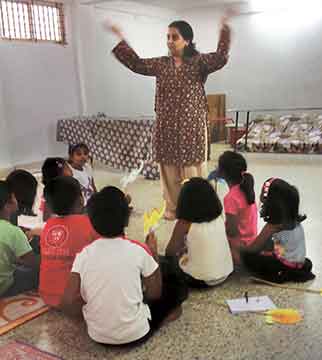Gowri Iyer
I am a professional storyteller and an involved mother. I have two sons and they are the reason I became fascinated with stories. My most favourite story is my own. So today I’d like to tell you my story.
 The setting
The setting
Sometimes as a mother, I was often lost. Do I tell my children what is right? Or do I leave it to them to explore and find out? Telling them would mean they have a head start. And letting them explore would mean they become independent thinkers. They would face the consequences and learn on their own. I most often chose to let them learn about right and wrong themselves. Sometimes this strategy worked and sometimes it didn’t. But stories came in handy in all situations…
…you know what happened when she talked to a stranger (guiding)?
…if you were in his situation, what do you think you would have done (letting them think)?
Now for the last four years, I have been working with children in the age group of 5 to 14. I am part of an organization called Cilre, which makes learning engaging, available, and relevant. And I need stories to tell all the time; to introduce concepts like the evolution of communication technology, the myths behind the formation of the earth, the birth of political systems, land forms, emotional awareness, probability, etc.
At Cilre, I facilitate the topic mostly in the story form, and then let the children explore.
Character
I am greatly interested in dealing with children. I think happy children make happy learners, and happy learners are open-minded human beings. And these human beings promote great cultural growth in the society. I knew stories would come in handy in connecting with children.
The problem
The challenge was to create or select stories, design connected activities, and deliver them so that children benefit from them; so that they feel comfortable while learning concepts, exploring their way forward and creating something of their own, eventually.
I needed a flow, needed to polish my skills as a facilitator, to create an emotional connect, and to reach out to the audience, especially children. I needed help to understand the structure, the nuances to be added, the authority with which to deliver, the knack of appealing to the audience as if casting a spell, and to make the desired impact.
I was a cook. I needed to become a Master Chef.
The solution
At Kathalaya, an environment was created to support imagination and spontaneity.
The knowledge about different genres of stories.
The wisdom to use them for the right theme.
To present them in an interesting and engaging voice.
The power of sounds and silence.
The importance of empathy and emotions.
The choice of using your strengths to imprint your own style.
The confidence with which to deliver a message.
To appeal to the listener effectively.
To paint a beautiful picture and to make a visual impact with puppets, illustrations.
To see a lot of powerful storytellers in action.
To be confident enough to become one.
Just to go wild.
Just to be with the story.
The diploma helped.
 A professional storytelling diploma gives you the platform to check the facts about your imagination. Are you in it? Do you believe in your story? How confident are you with your message? This is a field where you mix facts and imagination in the correct proportion so that you reach out to people effectively while making an emotional connection. It’s not child’s play to appeal to children. It’s serious work. You need to have a broad perspective and also a structure, even to be open.
A professional storytelling diploma gives you the platform to check the facts about your imagination. Are you in it? Do you believe in your story? How confident are you with your message? This is a field where you mix facts and imagination in the correct proportion so that you reach out to people effectively while making an emotional connection. It’s not child’s play to appeal to children. It’s serious work. You need to have a broad perspective and also a structure, even to be open.
That’s where the professional diploma course in storytelling helps.
It wakes you up so that you are imaginative, gives you tools so that you and your society get transformed into a world where effective communication develops.
It’s a rewarding feeling that now I write stories for children. As storytellers, we have the responsibility and the pleasure of packaging whatever we have to communicate through this powerful medium and encourage a sensible, cultured world.
Let us do our best to snatch children away from the attraction of the television and violent video games and direct their energies in a more creative and productive way. Learning facts happens anyway, but absorbing them with feeling and emotion helps retain them. Storytelling can play a vital role in this aspect.
The author is the Creative Head of Cilre, an organization for children that makes learning exciting. She can be reached at gowri@cilre.com.
